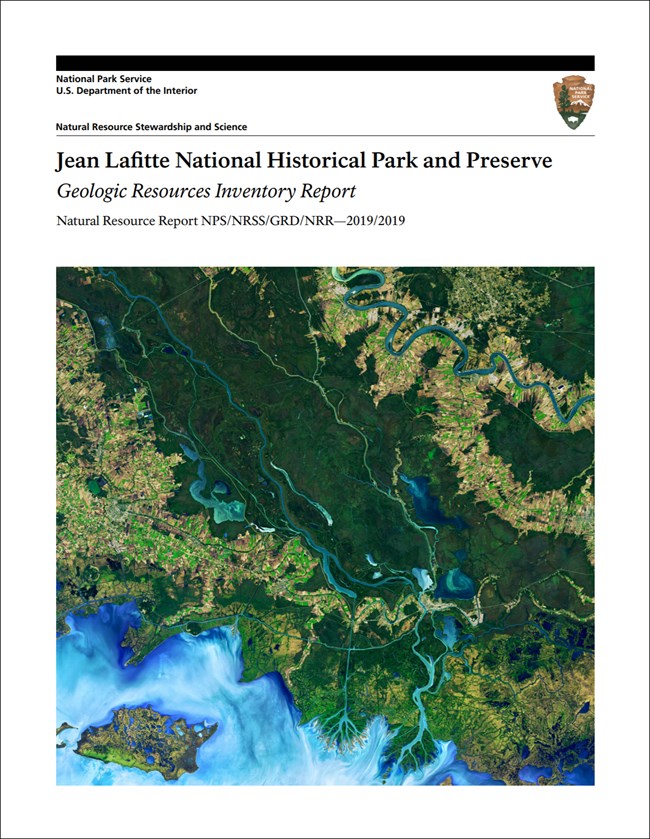Last updated: July 8, 2024
Article
NPS Geodiversity Atlas—Jean Lafitte National Historical Park and Preserve, Louisiana
Geodiversity refers to the full variety of natural geologic (rocks, minerals, sediments, fossils, landforms, and physical processes) and soil resources and processes that occur in the park. A product of the Geologic Resources Inventory, the NPS Geodiversity Atlas delivers information in support of education, Geoconservation, and integrated management of living (biotic) and non-living (abiotic) components of the ecosystem.

Introduction
Jean Lafitte National Historical Park and Preserve (JELA) consists of six individual park units distributed across the Mississippi River Delta region of southern Louisiana in portions of Evangeline, Jefferson, Lafayette, Lafourche, and Orleans Parishes. The historical park and preserve was authorized on November 10, 1978, and incorporated the previously established Chalmette National Historical Park (National Park Service 2016a). The park units of JELA encompass a combined 17,891 hectares (22,421 acres) and protects the diverse cultural and natural resources of southern Louisiana’s Mississippi River Delta. The six units that comprise JELA include: (1) Barataria Preserve Unit, featuring trails through protected bottomland forests, swamp, and marsh; (2) Chalmette Unit, including the Chalmette Battlefield and Chalmette National Cemetery that commemorate the 1815 Battle of New Orleans that was part of the War of 1812; (3) French Quarter Unit, containing the JELA headquarters and interpreting the diverse cultures of New Orleans; (4) Prairie Acadian Cultural Center; (5) Acadian Cultural Center Unit; and (6) Wetlands Acadian Cultural Center Unit. Together, the Prairie Acadian Cultural Center, Acadian Cultural Center, and Wetlands Acadian Cultural Center interpret the Acadian (Cajun) culture of the Mississippi River Delta region (Schupp and KellerLynn 2019). The park is named after Jean Lafitte, a French pirate, smuggler, and privateer who roamed the streets of New Orleans’ French Quarter, navigated the swamps of the Barataria Preserve, and supported Major General Andrew Jackson’s victory at the Battle of New Orleans (National Park Service 2015).
Geologic Setting
Jean Lafitte National Historical Park and Preserve is situated within the Mississippi Alluvial Plain region of the Coastal Plain physiographic province, an area defined by the broad, gently sloping alluvial plain of the Mississippi River. The geology of JELA is relatively young, consisting of Cenozoic sedimentary deposits dating back to the Pleistocene Epoch approximately 2.58 million years ago). The oldest deposits within the historical park are fluvially dominated strata of the Avoyelles Alloformation and Beaumont Alloformation that underlie portions of the Acadian Cultural Center and Prairie Acadian Cultural Center Units, respectively. Several unnamed Holocene fluvial deposits are also mapped within JELA that are associated with the ancestral and present-day Mississippi River and include deltaic lobe and natural levee deposits consisting of unconsolidated sand, silt, and clay. Sediments associated with the former St. Bernard delta lobe of the Mississippi River (4,500–2,000 years ago) are widely distributed across the Barataria Preserve Unit, while younger deposits of the Plaquemines lobe (750–500 years ago) underlie the eastern portion of Barataria (Byrnes et al. 2019). Natural levee deposits of the Lafourche meander belt of the Mississippi River (2,000–300 years ago) occur within the Wetlands Acadian Cultural Center (Byrnes et al. 2019).
Regional Geology
Jean Lafitte National Historical Park is a part of the Coastal Plain Physiographic Province and shares its geologic history and some characteristic geologic formations with a region that extends well beyond park boundaries.
- Scoping summaries are records of scoping meetings where NPS staff and local geologists determined the park’s geologic mapping plan and what content should be included in the report.
- Digital geologic maps include files for viewing in GIS software, a guide to using the data, and a document with ancillary map information. Newer products also include data viewable in Google Earth and online map services.
- Reports use the maps to discuss the park’s setting and significance, notable geologic features and processes, geologic resource management issues, and geologic history.
- Posters are a static view of the GIS data in PDF format. Newer posters include aerial imagery or shaded relief and other park information. They are also included with the reports.
- Projects list basic information about the program and all products available for a park.
Source: Data Store Saved Search 2907. To search for additional information, visit the Data Store.
A NPS Soil Resources Inventory project has been completed for Jean Lafitte National Historical Park and Preserveand can be found on the NPS Data Store.
Source: Data Store Saved Search 2979. To search for additional information, visit the Data Store.
GRI Geology Image Gallery
Related Articles
Jean Lafitte National Historical Park and Preserve
National Park Service Geodiversity Atlas
The servicewide Geodiversity Atlas provides information on geoheritage and geodiversity resources and values within the National Park System. This information supports science-based geoconservation and interpretation in the NPS, as well as STEM education in schools, museums, and field camps. The NPS Geologic Resources Division and many parks work with National and International geoconservation communities to ensure that NPS abiotic resources are managed using the highest standards and best practices available.


